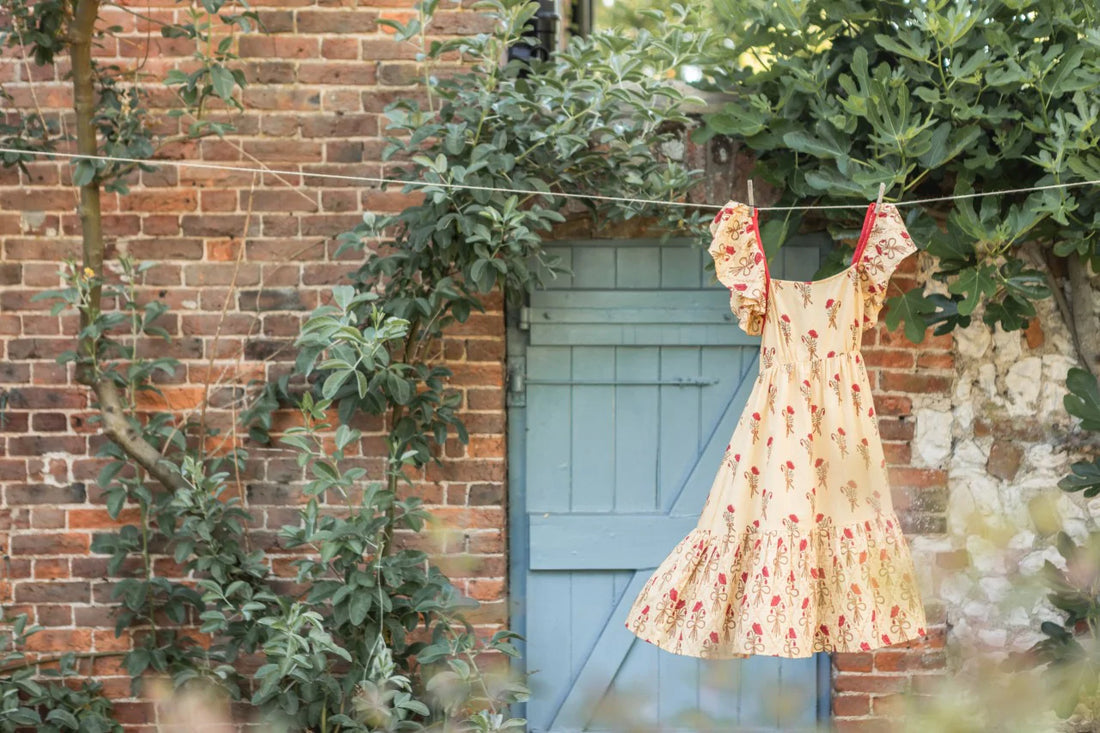
From illustration to block to cotton: Everything you need to know about block prints
Share
The art of block printing has been practised all over the world for thousands of years. Also known as 'woodblock printing', the technique is highly manual and labour-intensive and requires both skill and patience. But anyone who's seen block print fabric in the flesh will know how striking, original and beautiful it can be - meaning the hard work is worth it!
Whether you're interested in the origins of block printing, what exactly is involved in the process, or why brands (and buyers!) choose block printing over other types of textiles, we've got you covered. Here's our ultimate guide to block prints:
A brief history of block printing
While it's hard to pinpoint the exact starting point of hand block printing, it's believed that examples of the craft were seen in China as early as the third century. Woodblock printing then spread to Korea and Japan, with early prints tending to be information- and text-based rather than the decorative patterns we associate with block prints today.
Before the mechanisation of the printing process, hand-carving text, images and patterns on wooden blocks were seen as an efficient way of producing multiple versions of a print. Woodblock printing was a prevalent method for printing books, texts and images in East Asia until the 19th century.
While much of the world has moved on to highly-automated, machine-driven production processes, block printing is still alive and well in India. Rajasthan is the spiritual home of block printing, although the art form is practised across the country. Cities and states are known for their signature prints, including calico prints in Sanganer and Barmer's red chillies and trees.

How is block print fabric created? A step-by-step guide
Hand block printing is a true craft and art form. It's intensive work and a skill often passed down through generations. While different artisans may tweak their processes slightly, here's how our Hollyblocks team creates block print fabric:
- Our print designs are originals, drawn in the UK and taking inspiration from the wildflowers and other nature that surrounds us in Norfolk.
- The designs are copied onto tracing paper to transfer them to the wooden block. The wood may be teak, sycamore, rosewood, pear or something else entirely!
- The fabric (at Hollyblocks, we use organic cotton) is dyed. Our dyes are natural and non-toxic.
- The wood blocks are carved by hand by artisans in Jaipur. Craftspeople will use chisels, hammers and other tools to cut elaborate patterns into the blocks. This work is detailed and time-consuming; however once a block has been carved, it can be used for years.
- The carved blocks are painted with dye. They then act as stamps to print the colouring in uniform patterns across the cotton. Depending on the size of both the wooden block and the fabric, the pattern stamping process can take some time. Because of the hand-printed nature of this process, the resulting patterns are unique and can vary from garment to garment.
- Once the desired pattern is achieved, the fabric is hung up to dry in the sunshine.
- The fabric will then be stitched into the finished garments.

You can read more about the Hollyblocks process here. Interested in learning about how get inspired to creae our prints? Read all about it in our blog.
What are the advantages of block printing?
For anyone used to the mass-produced, machine-led fast fashion that dominates much of the western world, you might wonder why people would choose to produce clothing in this way. Here are just some of the reasons:
Tradition
When you choose a block print maxi skirt or mini wrap dress, you're not just selecting stylish summer fashion. You're also celebrating an art form that has flourished over centuries and helping to support the craftspeople who devote their lives to it. Block printing is one of the oldest textile art forms and, while it has embraced modernisation in the form of more modern styles and colours, it has stubbornly resisted industrialisation at every turn.
Uniqueness
Each piece of hand-block print clothing is a one-off work of art. From sketching the designs to carving the blocks and stamping the patterns onto the fabric, the human hand touches every step in the block printing process. This not only means pieces are made with love and care but also that there will be tiny differences and imperfections from one garment to the next, which adds a handcrafted uniqueness.
Supporting slow fashion
Slow fashion is increasingly important as a counterpoint to fast fashion, and some would say that block print clothing is slow fashion in its purest form. Its hand-crafted technique means mass production can't occur, with most block print fashion brands (including Hollyblocks!) releasing collections in small batches. Blocks can be used for decades if correctly cared for, and organic cotton and natural dyes help to keep the production process planet-friendly.
Support sustainable, independent fashion brands when you choose block prints
By somehow resisting modernisation and automation in an increasingly fast fashion-led consumer landscape, block printing shows us that there are other ways we can produce clothes.
At Hollyblocks, we firmly believe that feeling stylish shouldn't cost the earth. Our modern silhouettes, whimsical floral designs and muted pastel colours exist in harmony with the traditional. Why not try them for yourself? View our collection here.

